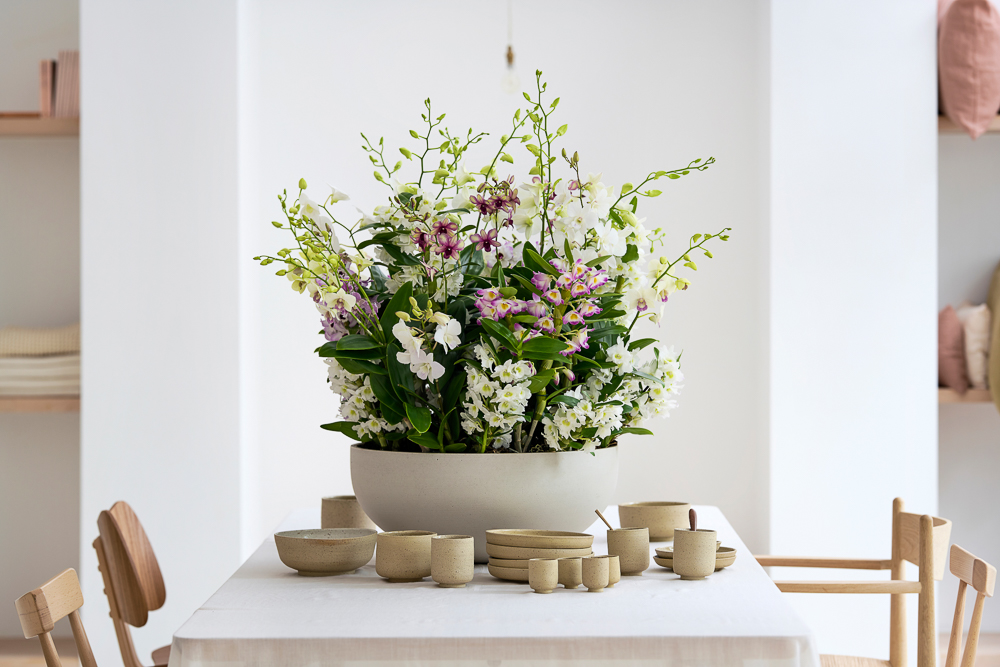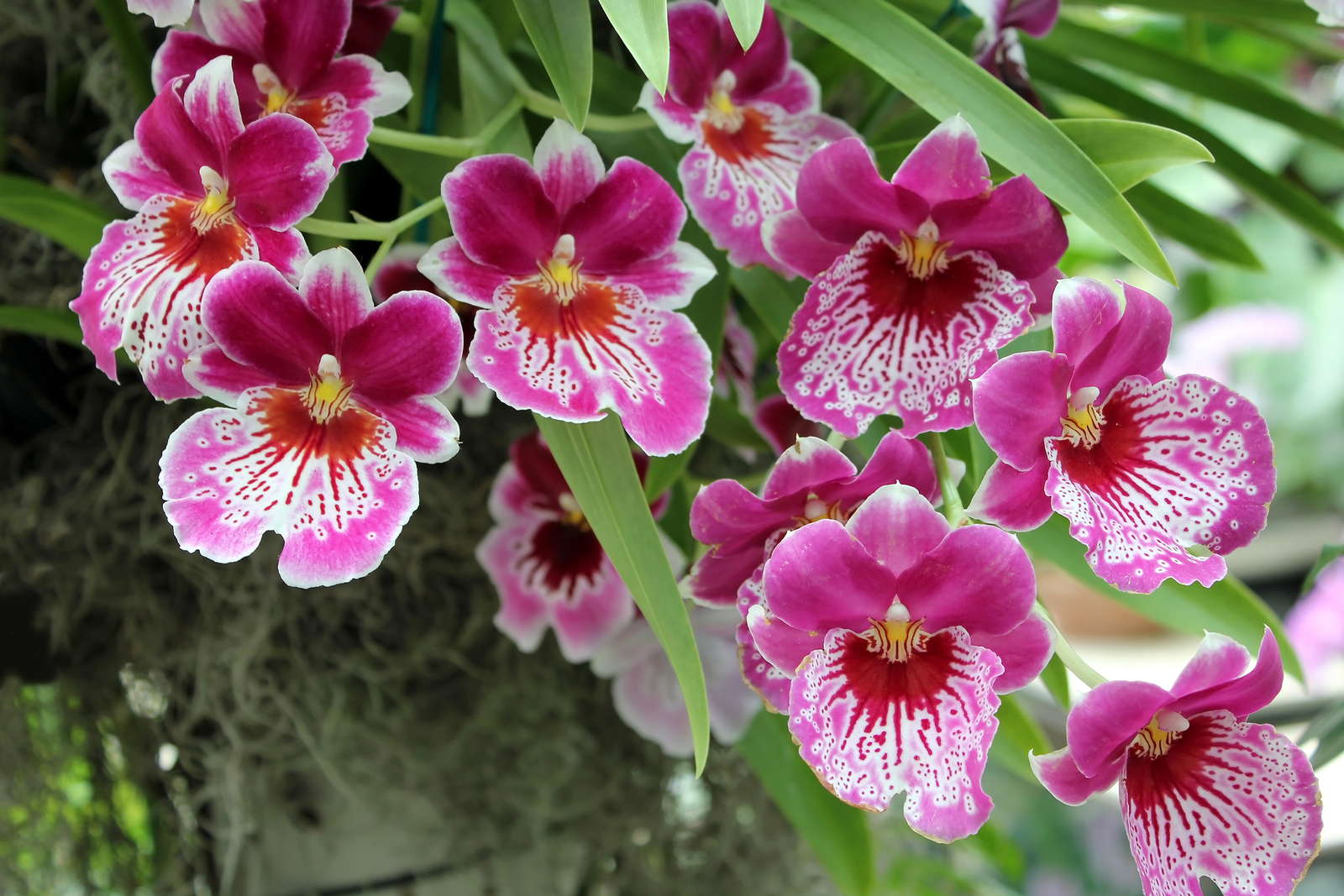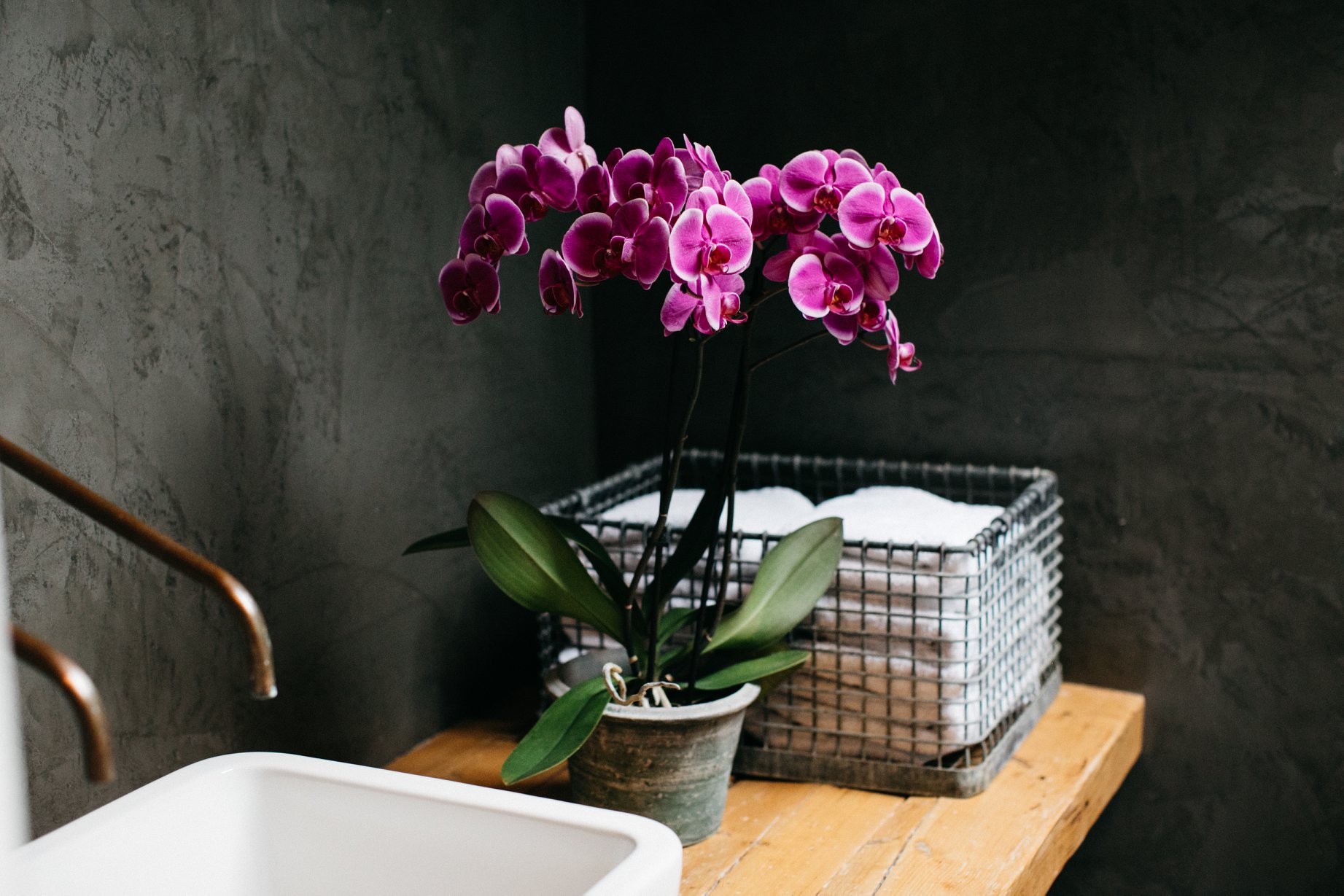Orchid types
These are the 11 most popular types of Orchids
The many different flower shapes and colours make the orchid a true design object. There are over 25,000 types of orchids, and every plant is unique. The best-known orchid species is the Phalaenopsis, also called the Moth Orchid. This classic beauty alone is available in hundreds of different shapes and colours. Other highlights from the orchid collection are the Oncidium (Tiger Orchid), Vanda, Dendrobium, Miltonia (Pansy Orchid), Cambria, Cymbidium and Paphiopedilum (Slipper Orchid). Read more about it in this article.
Types of Orchids
Cambria-like orchid
The Cambria-like is a hybrid of various plant species and therefore does not occur in the wild. It’s a collective name for a group of hybrid orchids, the ‘parent’ plants of which come from all over the world. The flowers vary in size and shape tremendously: from 1,5 cm to over 10 cm and from star-shaped to almost round. The flowers are beautifully marked. Brown, red and purple are the colours that predominate, but there are also pink, orange and brown Cambria-likes. The Cambria’s flowering period is about six weeks.
Read more about the Cambria-like orchid
Cattleya orchid
Cattleyas originate from Central and South America. Of all the types of orchids, the Cattleya has the most varied forms. There are large and small-flowered Cattleyas. The small-flowered cultivars have more flowers per stem than the large-flowered cultivars. Cattleyas catch the eye with their spectacular colours. The flowers are often scented, particularly when they are placed in daylight. The flowering period of the Cattleya is two to three weeks.
Read more about the Cattleya orchid
Cymbidium orchid
Cymbidium orchids have long, narrow leaves. The plant has at least one branch, but often more. The older a plant is, the more branches it can produce. These long branches carry six or more flowers, which can get pretty big: up to a diameter of 10 cm. Cymbidium’s colour spectrum ranges from white, yellow, green, pink and red to brown. Cymbidiums bloom for at least eight weeks with large flowers of five to eight centimetres.
Read more about the Cymbidium orchid
Dendrobium orchid
In the wild, the Dendrobium grows on trees and rocks. The name says it all: ‘dendron’ is the Greek word for ‘tree’ and ‘bios’ means ‘life’. There are two types of Dendrobium orchids:
- The compactum: they often have multiple canes (fully-grown pseudobulbs), and therefore also several branches with smaller flowers (1 to 7 cm). They come in white, blue and pink.
- The phalaenopsis hybrids: they have one or two branches with larger flowers (7 cm or larger). They come in white, pink, purple, blue, red, yellow, green, brown and cream.
The Dendrobium can flower in the living room for up to two months. After flowering, you can give the plant 6 – 8 weeks of rest in a dry and cooler place of about 15 ºC in, for example, a bedroom or utility room.
Read more about the Dendrobium orchid

Dendrobium
Dendrobium Nobilé orchid
This plant’s name too refers to the way it grows in the wild: preferably on trees, but sometimes also on rocks. The Dendrobium Nobilé differentiates itself from the other types of orchids by the cluster of flowers, which forms opposite the axil of each leaf. This unusual way of flowering on the stem gives the Nobilé a lifespan of at least eight weeks. The scented flowers are 5 to 8 cm across. The colour ranges from entirely white through yellow and orange to red and purple, and combinations of these colours.
Read more about the Dendrobium Nobilé orchid
Miltonia orchid
The Miltonia orchid, also called ‘Pansy Orchid’, prefers to grow on sloping river banks, or in any case outdoors. There are hundreds of species which vary greatly in terms of shape and size. There are large-flowered and small-flowered variants, but it’s mainly the large-flowered species that are grown commercially. Miltonia is a pseudobulb-forming plant with one or more branches and around five flowers on each branch. It has between one and four (or even more) branches. The Miltonia orchid comes in many colours, like white, yellow, pink, red and purple. The ‘mask’ is the most eye-catching feature. The Miltonia blooms for five to six weeks.
Read more about the Miltonia orchid

Miltonia
Oncidium orchid
The Oncidium orchid is also called the Tiger Orchid and the ‘Dancing Princess’. She owes the latter nickname to the special shape of her flowers, which resembles a ball gown. The flowers of the Oncidium are usually about 2 cm in size and the flowering period lasts about six to eight weeks. There are a large number of flowers on each branch. Oncidiums are mainly available in yellow and russet, but also in other colours ranging from white to shades of brown.
Read more about the Oncidium orchid
Paphiopedilum orchid
The Paphiopedilum orchid is also called the Lady’s Slipper or Slipper Orchid. She owes that name to the shoe-shaped lip, that serves as an insect trap. Flying insects are lured with scent and the promise of nectar in the flower. They can only get out through a narrow opening whereby they pass the pistil and the stamens and get the pollen on their body. At the next flower, the pollen then ends up on the pistil. Paphiopedilum blooms for an average of six to 10 weeks.
Read more about the Paphiopedilum orchid
Phalaenopsis orchid
The Phalaenopsis is the most common type of orchid, also called the Moth Orchid. The Phalaenopsis is available all year round from florists and garden centres and sometimes also from DIY stores and supermarkets. Phalaenopsis easily blooms for two months and often longer. There are small-flowered species – also called multiflora – with a lot of small flowers as well as standard species. And there are large-flowered species – grandiflora – with flowers which are at least 10 cm across. Phalaenopsis occurs in white, yellow, pink and purple and there are also species with unusually shaped and marked flowers.
Read more about the Phalaenopsis orchid

Photo: Anthura
Vanda orchid
Vanda grows and blooms on trees. The aerial roots act as sponges and can rapidly absorb a great deal of moisture. These roots also ensure that the plant remains firmly anchored to the tree on which it is growing. The plant therefore does not need any earth, potting soil even causes the roots to rot. The Vanda is available in small-flowered and large-flowered varieties. It comes in various colours, from tiny orange to gigantic blue/pink. Vandas are rare orchids and can only be bought at the better florists and garden centres. Flowering lasts between six to eight weeks on average.
Read more about the Vanda orchid
Zygopetalum orchid
Zygopetalum originates from South America. In the wild, this orchid grows on tree trunks and rocks in damp surroundings. They are available in various flower sizes, ranging from 2 to 10 cm. A new shoot forms a new branch, on which at least three flowers will appear. Zygopetalum is available in blue, red, purple and white shades. Flowering lasts about six weeks. Some Zygopetalum cultivars can produce a delightful scent during flowering.
Read more about the Zygopetalum orchid
Exceptional orchids
Sometimes your quest for orchids brings you face to face with a very unusual variety. These exceptional orchids are grown in small quantities and have limited availability. Examples of such exceptional orchids are: Epidendrum, Ludisia, Masdevallia, Erythraeum, Promenaea, Spathoglottis, Psychopsis, Angraecum, Encyclia cochleata (Octopussy orchid), Macodes and Maxillaria. The best chance of finding an exceptional orchid is at the better florists and garden centres. Another exceptional orchid is the Garden Orchid, such as the hardy Cypripedium. This type of Garden Orchid is sold in the spring and in the autumn when the plant is hibernating.
